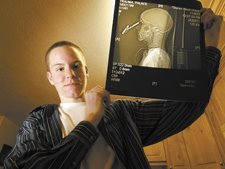From an e-mail from the Emergency Department Practice Management Association (EDPMA):
Budget Bill Includes Changes to Medicaid for Emergency Departments
The vast budget reconciliation bill contains numerous provisions affecting Medicaid and Medicare. Many of the Medicaid provisions have been touted as reforms by the [ http://www.nga.org/portal/site/nga ]National Governors Association that would allow greater program flexibility for States. One such flexibility that would affect Emergency Departments is in the area of beneficiary cost sharing and co-payments.
Medicaid Emergency Room Co-payments for Non-Emergency Care Provided in the ED
The budget reconciliation report would create a State option under Medicaid to allow hospitals to impose cost sharing for non-emergency care provided in an emergency department. The State option would be available through the Medicaid state plan amendment process beginning January 1, 2007. States would be able to allow hospitals to impose co-payments where the individual has actual access to an alternate non-emergency services provider that can competently provide the relevant services. Non-emergency services is defined as any care or services furnished in an emergency department of a hospital that the physician determines do not constitute an appropriate medical screening examination or stabilizing examination and treatment required by EMTALA. Alternate non-emergency services provider means a health care provider, such as a physician’s office, health care clinic, and community health care center, hospital outpatient department, which can provide clinically appropriate services for the diagnosis or treatment of a condition.
Requirements on the ED and Hospitals
A hospital would be required to inform the Medicaid beneficiaries of the following:
(1) The hospital may require the payment of cost sharing prior to the provision of services,
(2) The name and location of an alternate non-emergency service provider that is actually available and accessible,
(3) That the alternative provider can provide the services without cost sharing, and
(4) The hospital provides a referral to coordinate the scheduling of treatment with the alternate provider.
Note that additional requirements could be enacted through legislation, developed by the States in their Medicaid State plan amendment, or enacted under State law or regulation.
Limitations on Cost Sharing
The statute limits the amount of cost sharing. For most beneficiaries and services, the statute would limit cost sharing to twice the standard nominal cost sharing amount allowable under Medicaid. For those populations and services that are otherwise not subject to cost sharing in Medicaid, cost sharing is limited to the standard nominal amount allowable under Medicaid. Note that other sections of the Budget Reconciliation Conference Report would allow states greater flexibility to require higher levels of cost sharing in Medicaid than is currently allowable under law. These changes in federal law and those changes that could follow at the state level could raise the cost share limitations that hospitals could collect under this new legislation.
Liability Shield for Hospitals and Physicians
The House-passed version of the budget reconciliation bill would have created limited liability shield for hospitals and physicians wherein liability in a civil action of proceeding for the imposition of cost-sharing under this specific federal law would be barred absent a showing of gross negligence. This protection would have been very limited because traditional state laws and EMTALA requirements would still apply to hospitals and would not have been affected by this new law. This provision is one of three in the budget bill that was stricken by the point of order by the Senate on December 21 (see above).
Authorized Grants to States for Alternate Non-Emergency Services Providers
The law authorizes $50 million in grants to states in order to establish alternate non-emergency service providers or networks of such providers. Preference is to be given to rural or underserved areas or providers that are in partnership with local community hospitals. Note that this legislation authorizes these funds but does not have the authority to appropriate the funds. Therefore, any such program would be contingent upon future appropriations.
EDPMA worked on your behalf to improve these provisions during the drafting of the legislation. Improvements included a specific mention that the prudent layperson standard would not be affected, clarification that co-payments would be for NON-emergency services, language indicating that the physician id the determination of whether the service qualifies as “emergency services” or “non-emergency services.”
State Flexibility on Cost Sharing
The House-passed Budget Reconciliation Conference Report would allow States greater flexibility to impose cost sharing on Medicaid beneficiaries including premiums and co-payments. Such requirements are to be means tested with only traditional (nominal) cost sharing allowable for beneficiaries with incomes below 100 percent of the federal poverty line, some additional cost sharing allowable for beneficiaries with incomes between 100 and 150 percent of the federal poverty line, and the most state flexibility to impose cost sharing on beneficiaries with incomes higher than 150 percent of the federal poverty line.
The legislation specifically excludes emergency services from such cost sharing. However, as fully described above, states would have the option to allow cost sharing for non-emergency services furnished in the emergency department.
Emergency Services Provided by Non-contract Providers for Medicaid Managed Care Enrollees
Another provision of the budget reconciliation conference report would require Medicaid providers that provide emergency services to a beneficiary enrolled in a Medicaid managed care organization in which the provider does not have a contract to accept as maximum payment the Medicare fee-for-service rate.










